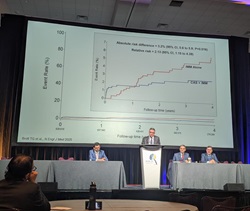
The international CREST-2 study has found that, for people with severe carotid artery narrowing who have not experienced recent stroke symptoms, a minimally invasive carotid artery stenting (CAS) procedure—combined with intensive medical therapy—significantly lowered stroke risk compared with medical therapy alone. The more traditional surgical approach of carotid endarterectomy (CEA) did not show the same benefit, however.
The research was presented today at the 2025 Society of Vascular and Interventional Neurology (SVIN) annual meeting (19–22 November, Orlando, USA) by James Meschia (Mayo Clinic, Jacksonville, USA), and has also been published in the New England Journal of Medicine.
CREST-2 was funded by the US National Institutes of Health (NIH), and is said to be the largest study to date comparing current treatment approaches for carotid artery disease caused by plaque buildup in the arteries supplying blood to the brain. According to the study researchers, although surgery and stenting have long been used to open these arteries, newer medications and better risk-factor control have raised questions about whether such procedures are still needed for people who do not have symptoms.
“Decades ago, surgery clearly helped prevent strokes in many patients,” said co-principal investigator and study senior author Thomas Brott (Mayo Clinic, Jacksonville, USA). “But medical therapy has improved so much that we needed to re-examine the balance between benefit and risk for people who have no symptoms.”
The CREST-2 programme consisted of two parallel, randomised clinical trials conducted at 155 medical centres in five countries: Australia, Canada, Israel, Spain and the USA. Each of the trials enrolled more than 1,200 adults with severe carotid artery narrowing of 70% or greater who had not had a stroke or transient ischaemic attack in the past six months.
In one trial, participants received either stenting plus intensive medical therapy or medical therapy alone, and, in the other, participants received endarterectomy plus medical therapy or medical therapy alone. All participants received comprehensive medical care—including lifestyle coaching and medication as needed—to manage their blood pressure, low-density lipoprotein (LDL) cholesterol and diabetes, and to help them stop smoking.
Researchers analysed the occurrence of stroke and death within 44 days of stenting or surgery, and the occurrence of stroke over the course of four years on the same side of the body as the narrowed artery.
The trial comparing stenting versus medical therapy found a significant reduction in stroke; over four years, 2.8% of patients treated with stenting and medical therapy had a stroke compared to 6% of those on medical therapy alone—roughly halving the risk of stroke. However, in the endarterectomy trial, the difference in stroke rates—3.7% with surgery plus medical therapy versus 5.3% with medical therapy alone—was not statistically significant. In addition, serious complications were shown to be uncommon with either procedure.
Following Meschia’s presentation at the 2025 SVIN meeting, Tudor Jovin (Cooper University Health Care, Camden, USA) described this as a “historical day for interventional neurology”, also noting that the primary results from CREST-2 are “unexpected, but incredible for our field”.
The findings are believed to provide clearer guidance for physicians and patients considering a preventive procedure for carotid artery stenosis, with Brott emphasising the importance of personalised decision-making as well.
“For some patients—particularly those with more advanced narrowing, or plaque that appears unstable or more likely to cause a blockage—stenting may offer added protection, while, for others, medical therapy alone may be enough,” he stated.
Close follow-up and coordinated care helped all participants in CREST-2 achieve and maintain significant improvements in their blood pressure and cholesterol levels, the researchers further claim.
Brott, Meschia and colleagues will continue to track participants for long-term results, and they are also currently studying whether imaging tools can help identify which patients benefit most from each treatment.









